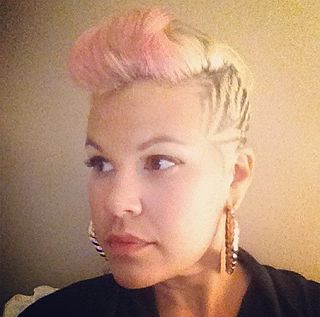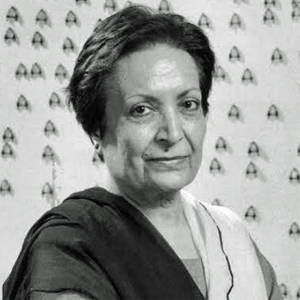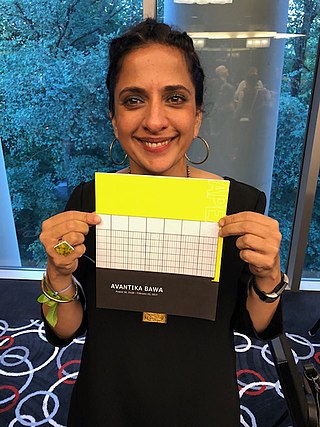Related Research Articles

Site-specific art is artwork created to exist in a certain place. Typically, the artist takes the location into account while planning and creating the artwork. Site-specific art is produced both by commercial artists, and independently, and can include some instances of work such as sculpture, stencil graffiti, rock balancing, and other art forms. Installations can be in urban areas, remote natural settings, or underwater.
Barbara Rossi is a Chicago-based artist, one of the original Chicago Imagists, a group that in the 1960s and 1970s turned to representational art. She first exhibited with them at the Hyde Park Art Center in 1969. She is known for meticulously rendered drawings and cartoonish paintings, as well as a personal vernacular. She works primarily by making reverse paintings on plexiglass that reference lowbrow and outsider art.

Mary Lee Hu is an American artist, goldsmith, and college level educator known for using textile techniques to create intricate woven wire jewelry.

Sharon Louden is an American artist known for her whimsical use of the line. Her paintings, drawings, animations, sculptures, and installations are often centered on lines or linear abstractions and their implied actual movement. Through her work, she creates what she calls "anthropomorphic individuals." Although abstract and formal, she feels they have human-like aspects within their minimal state, made of simple lines and gestures. In reference to her minimalist paintings, Louden has been called "the Robert Ryman of the 21st century."

Geeta Kapur is a noted Indian art critic, art historian and curator based in New Delhi. She was one of the pioneers of critical art writing in India, and who, as Indian Express noted, has "dominated the field of Indian contemporary art theory for three decades now". Her writings include artists' monographs, exhibition catalogues, books, and sets of widely anthologized essays on art, film, and cultural theory.

Heather T. Hart is a visual artist who works in a variety of media including interactive and participatory Installation art, drawing, collage, and painting. She is a co-founder of the Black Lunch Table Project, which includes a Wikipedia initiative focused on addressing diversity representation in the arts on Wikipedia.

Donald Lipski is an American sculptor best known for his installation work and large-scale public works.
Rummana Hussain (1952–1999) was an artist and one of the pioneers of conceptual art, installation, and politically engaged art in India.
Cynthia Carlson is an American visual artist, living and working in New York.
Joyce J. Scott is an African-American artist, sculptor, quilter, performance artist, installation artist, print-maker, lecturer and educator. Named a MacArthur Fellow in 2016, and a Smithsonian Visionary Artist in 2019, Scott is best known for her figurative sculptures and jewelry using free form, off-loom beadweaving techniques, similar to a peyote stitch. Each piece is often constructed using thousands of glass seed beads or pony beads, and sometimes other found objects or materials such as glass, quilting and leather. In 2018, she was hailed for working in new medium — a mixture of soil, clay, straw, and cement — for a sculpture meant to disintegrate and return to the earth. Scott is influenced by a variety of diverse cultures, including Native American and African traditions, Mexican, Czech, and Russian beadwork, illustration and comic books, and pop culture.

Zarina Hashmi, known professionally as Zarina, was an Indian-American artist and printmaker based in New York City. Her work spans drawing, printmaking, and sculpture. Associated with the Minimalist movement, her work utilized abstract and geometric forms in order to evoke a spiritual reaction from the viewer.
Harriet Bart is a Minneapolis based conceptual artist, known for her objects, installations, and artists books.
Annu Palakunnathu Matthew is a British photographer. Her work has been exhibited at the Rhode Island School of Design Museum; Guangzhou Biennial of Photography, China; Tang Museum, New York; and The Smithsonian National Museum of Natural History. Matthew is a professor of art (photography) in the University of Rhode Island's Department of Art and Art History.

Nalini Malani is a contemporary Indian artist widely acknowledged to be among the country's first generation of video artists. She works with several mediums which include theater, videos, installations along with mixed media paintings and drawings. The subjects of her creations are deeply influenced by her experience of migration in the aftermath of the partition of India. Subsequently, pressing feminist issues have also become a part of her creative output. Malani has evolved a visual language that is iconic, moving from stop motion, erasure animations, reverse paintings and most recently to digital animations, where she draws directly with her finger onto a tablet.
Dyani White Hawk is a contemporary artist and curator of Sicangu Lakota, German, and Welsh ancestry based out of Minnesota. From 2010 to 2015, White Hawk was a curator for the Minneapolis gallery All My Relations. As an artist, White Hawk's work aesthetic is characterized by a combination of modern abstract painting and traditional Lakota art. White Hawk's pieces reflect both her Western, American upbringing and her indigenous ancestors mediums and modes for creating visual art.

Elyn Zimmerman is an American sculptor known for her emphasis on large scale, site specific projects and environmental art. Along with these works, Zimmerman has exhibited drawings and photographs since graduating with an MFA in painting and photography at University of California, Los Angeles in 1972. Her teachers included Robert Heineken, Robert Irwin, and Richard Diebenkorn.

Avantika Bawa is an Indian American artist, curator, and professor of art. Bawa is a multidisciplinary artist who works primarily in site-specific installation, video, printmaking, and drawing. She is the recipient of the 2018 Crow's Shadow Institute of the Arts Golden Spot Residency Award, the Hallie Ford Fellowship in the Visual Arts, and the Oregon Arts Commission Joan Shipley Award.
Liza Sylvestre is an American visual artist born and raised in Minneapolis, Minnesota. She is known for detailed abstract mixed media paintings and drawings. Her current work explores new media such as installation and video art. Much of her work revolves around our sensory perceptions and misconceptions of the world around.
Karen Fitzgerald is an American artist based in New York City best known for working exclusively in the tondo form.
Pao Houa Her is a Hmong-American photographer whose works are primarily centered around the history and lived experiences of the Hmong people. Her's photography consists of greenery and geographic images. She is also a professor at the University of Minnesota and teaches Introduction to Photography.
References
- ↑ "Chicago artist hopes King Charles can do what his mother did not". Chicago Sun-Times. September 10, 2022.
- ↑ Banerji, Abigail (April 1, 2022). "Artist Pritika Chowdhry is bringing stories of India's partition to the global stage". Hindustan Times.
- ↑ Jacqui Palumbo. "'Anti-memorials' honor Indian Partition's unseen victims, 75 years on". CNN.
- ↑ Quraishi, Ash-har (5 October 2021). "Artist hopes to spark conversations about traumatic world events". WGBA-TV .
- ↑ Dar, Vaishali (17 April 2022). "A pop icon: How Andy Warhol continues to remain in the news". Financial Express .
- ↑ Micieli-Voutsinas, Jacque (2015). "What the Nation Re-members: Resisting Victim Nationalism in Partition Memorial Project". GeoHumanities. 1 (2): 398–413. doi:10.1080/2373566X.2015.1103196. S2CID 147050563.
- 1 2 3 Ramsay, Francesca (5 October 2021). "Memory Leaks Interview with Pritika Chowdhry and Francesca Ramsay".
- ↑ Jain, Siddhi (16 December 2021). "Reimagining Nirbhaya: An artist's ode to December 16 victim". Hindustan Times .
- 1 2 Mirza, Quddus (8 January 2012). "Of kites, kurties and cartography". The News International .
- 1 2 "'Karmic (Dis)Continuities' on display at Banfill". 23 April 2013.
- 1 2 "Artworks remember the crooked line". DAWN . January 3, 2012.
- 1 2 3 4 5 6 7 Narayanan, Jayashree (18 April 2022). "Artist Pritika Chowdhry's 'anti-memorials' illustrate what is excluded from collective memories of Partition". Indian Express .
- ↑ Benzine, Vittoria. "The Partition Memorial Project by Pritika Chowdhry".
- ↑ Lodaya, Nidhi (27 March 2022). "She confronts history". Mid-Day .
- ↑ "Installations" . Retrieved 22 May 2022.
- ↑ "Chicago-Based artist "anti-memorializes" the partition of India". September 26, 2022.
- ↑ "About" . Retrieved 22 May 2022.
- ↑ "Awards in the Creative Arts – Division of the Arts – UW–Madison". artsdivision.wisc.edu. Archived from the original on 18 April 2020. Retrieved 22 May 2022.
- ↑ "2011 American Institute of Indian Studies Fellows" (PDF). Retrieved 22 May 2022.
- ↑ White, Clarence (10 March 2014). "This week in Saint Paul".
- ↑ Kalra, Vandana (September 21, 2010). "Border Line". Indian Express.
- ↑ Chatterjee, Saibal (October 10, 2010). "The Sunday Tribune - Spectrum". Tribune India .
- ↑ "Erasing Borders: Passport to Contemporary Indian Art of the diaspora 2009" . Retrieved 22 May 2022.
- ↑ "Pritika Chowdhry | Woman Made Gallery" . Retrieved 22 May 2022.
- ↑ "About Pritika Chowdhry" . Retrieved 22 May 2022.